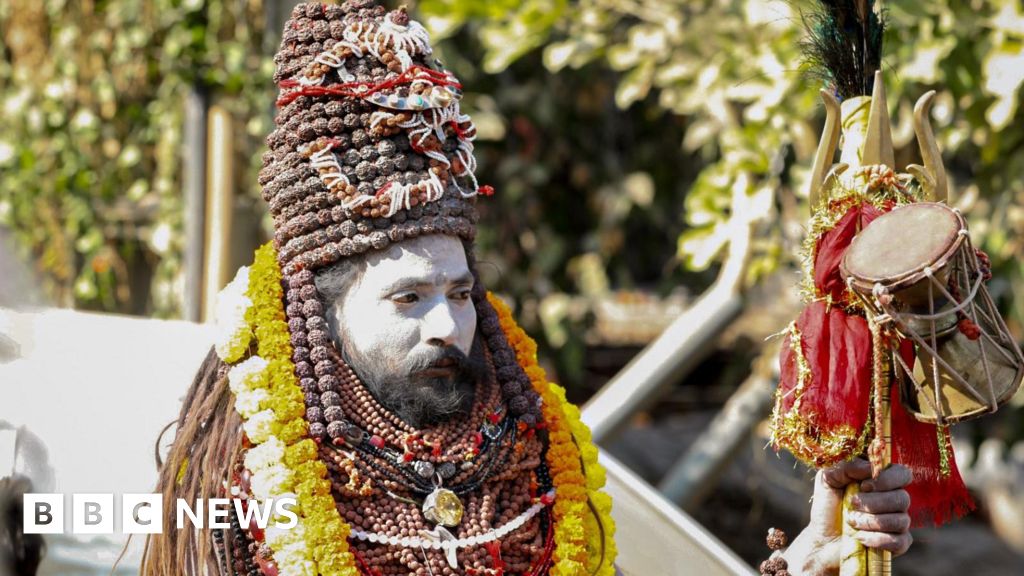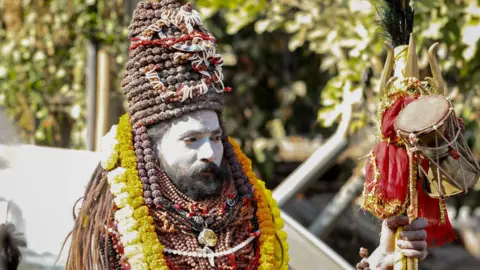 Ankit Srinivas
Ankit SrinivasAuthorities in India say more than 20 million people are expected to take part in the first major bathing day at the Hindu festival of Kumbh Mela (also known as the Mahakumbh), in the northern city of Prayagraj.
The day would kick off with the Naga sadhus – the ash smeared naked Hindu holy men with matted dreadlocks – taking a plunge in the icy waters at dawn.
The festival, held once every 12 years, started on Monday, with more than 16.5 million pilgrims bathing in the holy rivers.
Hindus believe that the bathing rituals will cleanse them of sins, purify their soul and help them attain salvation by liberating them from the cycle of birth and death.
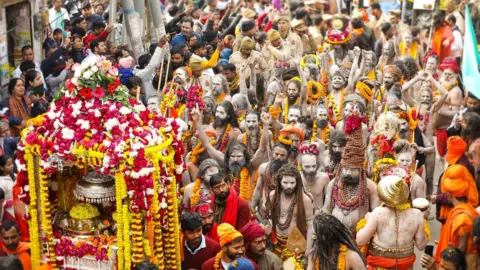 Ankit Srinivas
Ankit SrinivasOfficials say more than 400 million are expected to participate in the 45-day spectacle which is described as humanity’s biggest gathering. It is so large that it can be seen from space.
Tuesday’s bathing rituals, called the Shahi Snan – or the royal bath – will see the ascetics arrive in batches at the Sangam – the confluence of India’s most sacred Ganges river with the Yamuna river and the mythical Saraswati – in colourful processions.
Their outing is a major draw for people from across India and around the world who come to seek their blessings.
Their presence also holds a special significance for the great masses who believe that the river waters get imbued with the purity of the saints’ thoughts and deeds when they bathe in the river.
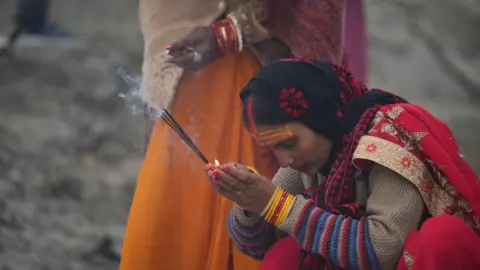 Ankit Srinivas
Ankit SrinivasWhat are the big bathing days?
There are six auspicious days to bathe this time, decided by astrologers, based on the alignment of specific planets and constellations. They are:
- 13 January: Paush Purnima
- 14 January: Makar Sankranti
- 29 January: Mauni Amavasya
- 3 February: Basant Panchami
- 12 February: Magh Purnima
- 26 February: Maha Shivaratri
Three of these – 14 and 29 January, and 3 February – have been designated as Shahi Snan days when the Naga sadhus will bathe.
The largest gathering is expected on 29 January when 50 to 60 million worshippers are expected to take to the waters.
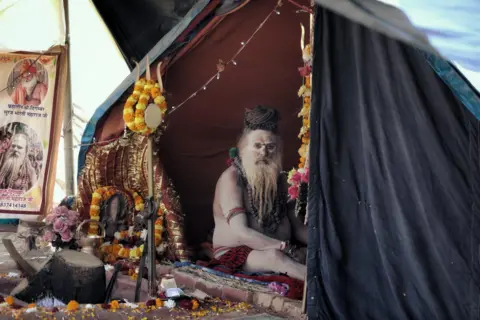 Ankit Srinivas
Ankit SrinivasAuthorities have built a sprawling tented city on the river bank spread over 4,000 hectares to accommodate the holy men, pilgrims and tourists visiting the festival.
For the past few days, we have watched groups of saints arriving at the mela grounds in large noisy processions.
One group of ash-smeared holy men, some naked and some dressed in just a loin cloth or marigold garland draped around their necks, marched through the streets, holding tridents, swords and small two-headed drums.
Another group had its leaders on chariots escorted to their campsite in a large procession with music bands, dancers, horses and camels.
The groups – known as akharas – have set up sprawling camps which have been a hive of activity, with tens of thousands of pilgrims visiting to hear religious discourses or attend evening prayers.
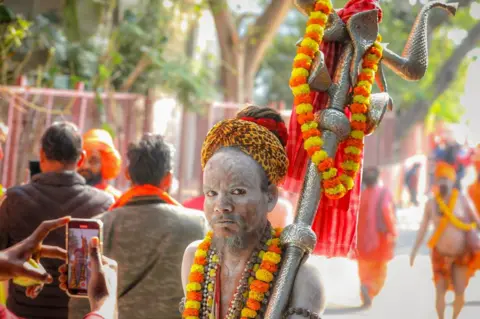 Ankit Srinivas
Ankit SrinivasThe origin of the festival is rooted in the mythological story about a fight between the gods and demons over a Kumbh (a pitcher) of nectar that emerged during the churching of the ocean.
As the two sides fought over the pot of elixir, a few drops spilled over and fell in four cities – Prayagraj, Haridwar, Ujjain and Nasik.
The Kumbh mela is organised in all the four cities, but the biggest festivals are always held in Prayagraj.
The bathing dates and auspicious times are decided by astrologers, based on the alignment of specific planets and constellations.
Hindu seer Mahant Ravindra Puri says the rare planetary alignments at present make this year’s festival “extra special” and “a Maha [great] Kumbh”.
Mahant Puri will be leading tens of thousands of holy men from his akhara to Tuesday morning’s bath.
“We believe that during Kumbh Mela, the waters of the sacred river will be imbued with nectar,” he says.
“And those who have faith, Ganga maiyya [the river goddess] will bless them with whatever they want, whatever they need,” he adds.
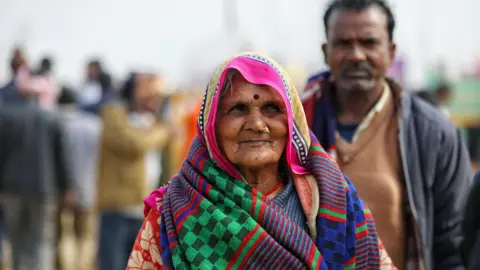 Ankit Srinivas
Ankit SrinivasBesides the saints and ascetics, Tuesday’s bathing will also see millions of ordinary pilgrims making their way to the river.
On Monday, in the mela ground, we met Chitiya Ahirvar who is visiting from her village in the central Indian state of Madhya Pradesh.
The 60-year-old who is travelling in a group of 20 bathed in the river in the morning and will be going back for a repeat on Tuesday .
“I prayed to the river goddess for my children’s well being and happiness,” she said.
Mavaram Patel, a businessman who is visiting from the southern state of Tamil Nadu, said he had heard a lot about the Kumbh Mela but did not have the opportunity to visit earlier.
“Kumbh Mela is part of our ancient tradition. It’s one of Hinduism’s most important festivals,” he told the BBC.
Mr Patel said he prayed to the river goddess for the “happiness and welfare” of his “family and the wider world” and plans to take a dip in the river on Tuesday morning too before leaving the city.
“Visiting Prayagraj and bathing during Kumbh was on my bucket list for a long time so I’m happy to be here,” he said.
